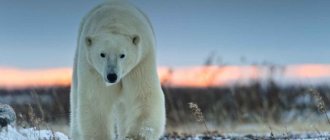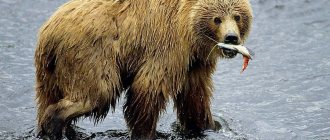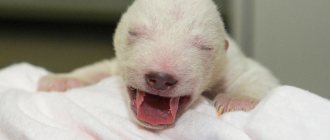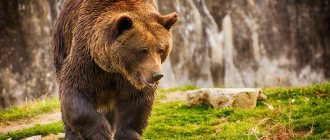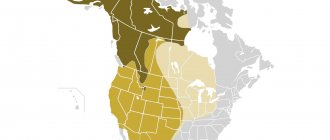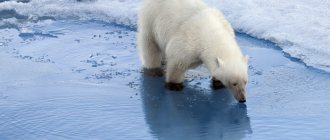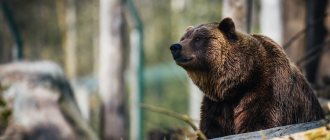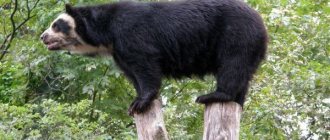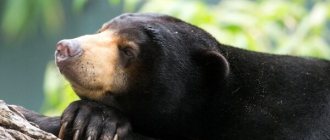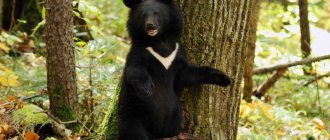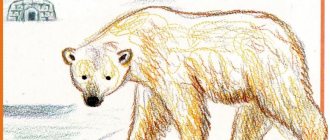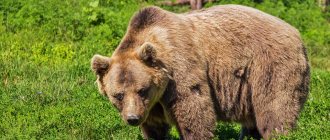Why polar bears will have a hard time surviving in a warming climate
For thousands of years, the polar bear has been feeding on meat and fatty foods, hunting on ice floes. The main object of his hunt is the seal. However, ongoing climate change is destroying the ice, depriving bears of ice floes from which they could get food.
As experts have found, polar bears have failed to adapt to climate change. This means that if sea ice completely disappears in the Arctic, this species could disappear from the face of the Earth.
Malaysian artist creates stunning surreal photo illusions
“Creativity and Creativity”: Rosobrnadzor is thinking about transforming the Unified State Exam
Traveling around Russia and saving: how to get some money back for your trip
Polar grizzly (Aknuk, Pizli, Grolar, Nakulak)
Aknuk, Pisli, Grolar, Nakulak, Polar grizzly - these are the many names that appeared for the hybrid of a white polar bear and a brown grizzly bear. This interspecific hybrid is found both in nature and in zoos. An amazing example of “love” between two different species of bears. The fact is that both bears live nearby, but do not overlap in their habitats, so grizzlies prefer to live on land, but polar bears have their eye on ice and water. But, apparently, they still sometimes intersect.
Such hybrids have long been found in zoos, but in nature it was believed that this was practically impossible. This bear was considered a “cryptid,” that is, a purely hypothetical animal that does not exist in nature.
But as history has shown, this is not so. In 2006, in the Canadian part of the Arctic, American hunter Jim Martell found and shot what he thought was a polar bear, but after examining it, he saw that something was wrong here, he was the first to suggest that the victim was a hybrid of a polar bear and a grizzly bear. And then the problems began, the fact is that Jim had a license to shoot only a polar bear (by the way, it cost more than $40,000 at that time), but shooting a grizzly bear is a heavy fine and up to 1 year in prison. In April 2006, it was decided to send the animal's corpse to British Columbia to determine its species. The answer was not long in coming, and on May 11, 2006, the journal Wildlife Genetics International stated that the killed bear was the first confirmed representative of the hybrid line discovered in the wild. The scientists' findings were confirmed by DNA analysis. It is worth mentioning that this is not the first such bear that hunters have encountered, but then DNA analysis was not possible, so the first unconfirmed hybrid was described in 1864 by Clinton Hart Marian, a zoologist who described the animal killed near Rendezvous Lake. The bear was a dull white coloration with a golden brown muzzle. Based on the description, we can conclude that this is the first mention of interspecific hybridization of these bears.
Genetically, the polar bear and the grizzly bear are very similar, but the sexual season for polar bears begins earlier. In zoos it has been proven that hybrids are fertile (at least the first generation).
If we take the species affiliation (according to genetic criteria), then roughly speaking, the polar bear and the grizzly bear belong to the same species, but morphologically they are quite different, and since the animals live in different areas, mating with each other is very rare. Therefore, for many centuries, even if animals mated, the mixing of the gene pool was minimal.
In 2010, the world heard about the peasely again, so hunter David Kuptan killed a bear that looked like a hybrid of a white and a grizzly bear, after DNA analysis it became clear that this was the first confirmed hybrid of the second generation, that is, his mother was a hybrid of a polar bear and a grizzly bear, and dad was a grizzly bear.
Let's look a little at history, for the first time such a hydride was obtained in 1874 at the London Zoo, the resulting bears were white at birth, but with age they acquired a bluish-brown or yellow-brown color. The hybrids were fertile and crossed both with each other and with the parent individuals. In 1876, the experience was repeated in Germany, where a female European brown bear gave birth 4 times to a male polar bear; currently, a stuffed animal of one of their children (an adult, of course) is in the Rothschild Zoological Museum in Tring (Great Britain).
Recently, cases of such hybridization are becoming more and more common, for example, in Alaska, due to global warming, the range of polar bears has expanded by hundreds of kilometers, and in the Canadian province of Monitoba, grizzly bears have begun to be found in those territories where previously only polar bears lived.
this is what usually happened in zoos
We should talk about the “fruits” of such love. Bear cubs are born strong and fertile, their fur is lighter and their diet is more taken from polar bears, so young hybrids almost do not eat grass and berries, feeding exclusively on fish and small animals.
The kids fiercely protect their possessions and rarely avoid conflict, which is a characteristic character trait of the grizzly bear.
As you can see, this type of bear has many names, there is no consensus yet, but a number of researchers suggest calling it nanulak or pizzly if the mother is a hybrid grizzly bear, and the father is a polar bear, and aknut and grolar if the mother is a polar bear, and the father is a grizzly bear. Although there is no consensus here yet.
For understanding:
Peasley is a polar grizzly...
Nanulak - Inuit people inhabiting the territory where hybrids were found called the grizzly bear Aklak, and the polar bear - Nanuk, put two words together and it turned out to be Nanulak.
Aknuk is the same as nanulak, only the parents are opposite.
Grolar - from the English grizzly - Grizzly Bear and polar bear - Polar Bear
How modern warming is leading to the emergence of a new species of bear
The retreat of ice towards the North Pole makes it increasingly difficult for polar bears to reach the ice floes. Some of them began to go inland in search of food sources. This food can hardly cover their vital needs, since it is tougher, and they are not used to it. On their way south, they begin to come into contact with grizzly bears, which climate change, on the contrary, is pushing north.
Scientists have noticed that the mixing of their habitats leads to the fact that they begin to mate with each other. Similar events were recorded in Alaska. The result of this crossing was a hybrid that is better adapted to climate change, but at the same time carries the genes of a polar bear. They called him a “teddy bear.”
POLAR GRIZZLY: Grolar – a hybrid of a polar and brown bear | Interesting facts about bears and animals
Greetings, dear naturalists. Zoo channel is with you. We are collecting a large video encyclopedia about all types of animals on the planet. Love nature with us, subscribe and like, they help more people learn about the animal world.
Friends, we always follow in the footsteps of past videos and material already studied. And, of course, according to your requests for the review of animals. Last time, we first encountered hybrids using the example of a liger, the largest cat in the world (a hybrid of a tigress and a lion). Moreover, I want to note that these hybrids were obtained naturally, and not by selection. It’s just that tigers and lions, living in the same territory, can give birth to offspring, because they belong to the same genus of panthers.
So our guests today are quite compatible with each other.
You meet the pizzly or grolar, also known as the polar grizzly, an interspecific hybrid of the polar bear and the grizzly, that is, the brown bear, recorded both in captivity and in the wild. For those who didn’t know, a grizzly bear is a brown bear, just with an American registration.
The polar bear and the grizzly bear (a subspecies of brown bear found in western Canada and Alaska) are very similar genetically and can produce fertile offspring. Moreover, these species are clearly distinguished by a whole range of morphological characteristics, and their crossing occurs so rarely that the mixing of genetic material is minimal.
The first reliable information about the creation of a hybrid of a brown and a polar bear was obtained at the zoo in the German city of Halle, where, starting in 1874, hybrid cubs were born several times. Several of these cubs subsequently lived in the London Zoo. Hybrid bears from Halle turned out to be fertile both when mating with each other and with their parent species. These Halle hybrids were white at birth, but later became bluish-brown or yellow-brown. Since 1876, at a zoo in Germany, a female European brown bear has sired offspring with a male polar bear four times. Now a stuffed adult hybrid of a European brown and polar bear, born in the 19th century, is on display at the Rothschild Zoological Museum in the UK.
In nature, only three confirmed cases of hybridization are known. Why?
Yes, because, despite the fact that brown and polar bears are genetically similar and are often found in the same territory, they tend to avoid each other. I don’t know what kind of spring should make them become friends like that.
Kodiak Island bears in Alaska tend to live inland and inland, while polar bears prefer water and ice. Some scientists suggest that due to global warming, which has led to a decrease in the area of polar ice, polar bears are forced to develop large territories, often moving a hundred kilometers or more from the sea coast. Over the past decade, several grizzly bears in Canada have been recorded moving into areas where only polar bears were previously found. Perhaps more frequent encounters due to greater overlap of grizzly and polar bear habitats may further lead to more frequent hybridization and we will have a new subspecies with the indecent name of pizzly.
Grolars have behavior more similar to that of polar bears. From their polar ancestors they inherited light color and aggressiveness. Grolars eat fish and animals, and do not trade for berries and roots, like brown bears. 80% of the grizzly's diet consists of plant foods, and polar bears are the most meat-eating meat-eaters in the world, because almost nothing grows in the Arctic.
Their hunting behavior manifests itself at an early age: in zoos, bear cubs trample toys, as polar bears do, breaking ice, and also throw them to the sides, as polar bears do, killing prey. Such throwing movements are not observed in grizzlies. In addition, hybrids crawl on their bellies, spreading their hind legs - this behavior is characteristic of polar bears.
In 2022, the Department of Environmental Conservation officially announced that the first second-generation Grolar had been discovered in the wild. It was decided to call hybrids pizzly and nanulaki if the mother is a grizzly bear and the father is a polar bear, and to call them grolar or aknuk when the mother is a polar bear and the father is a grizzly bear.
Thus, it turns out that the main reason for the appearance of polar grizzlies is global warming. If the stomach of a grizzly bear is well adapted to plant foods, then polar bears are forced to migrate from the melting Arctic to the continent in search of meat, where they find their interracial love. Scientists are worried that such interspecies interbreeding will affect biodiversity, it could lead to either the extinction of one of the species or the replacement of someone with a pizlee.
Do you think that such interracial marriages between bears in the wild will become more frequent, and what could this lead to? Write your opinion in the comments!
Become sponsors of the project for only 99 rubles per month. By doing this you will help popularize zoology, which is very important in the modern world.
Also, I draw your attention to the fact that we now have designer branded T-shirts from the channel. You can purchase them using the links in the video description.
Thank you for watching this video. Don't forget to like, write comments about what animal you would like to see in the next video, and share this video with your friends, this greatly helps the development of our small community. Subscribe to our public pages using the links in the video description, there is a lot of interesting stuff there. There was a channel about animals Zoo with you. We are collecting a large video encyclopedia about all types of animals on the planet. Love nature with us. See you soon.
What else have scientists found out?
To understand whether the polar bear could adapt to the new diet, the researchers analyzed the remains of 20 polar bears (10 jaws and 10 skulls) found during archaeological excavations. Some of them date back 1,000 years, during the so-called medieval warming period. However, even then there were no signs of eating hard food on their teeth.
The researchers also found that polar bears of that time were no different from modern ones, some of which are now forced to change their traditional diet, switching to more solid food.
Grizzly and white bears had a common ancestor a long time ago - 500-600 thousand years ago, after which they existed as independent species of animals. The polar bear has larger canines, but smaller molars. This structure is associated with their traditional diet, which is dominated by fat. And the elongated skull is optimal for seal hunting. However, it can interfere with the transition to more solid foods.
Found a violation? Report content
